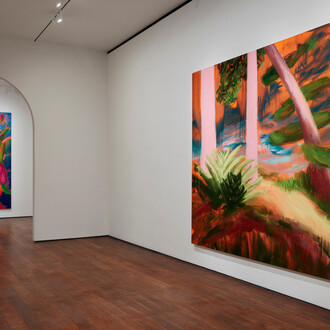Acquavella Galleries is pleased to present The Worlds of Joaquín Torres-García, an exhibition comprised of over sixty paintings, sculptures and works on paper from 1896 to 1949. Drawn from the private collection of the family of the artist, this group of works has never been exhibited as a whole, although individual pieces have been loaned to major museums across Europe and South America. This show represents the largest and most comprehensive survey in an American gallery since Joaquín Torres-García curated his own exhibition at The Sidney Janis Gallery in 1950.
Best known for his semi-abstract paintings of universal symbols that emphasize the contrast and synthesis between “classical” and “modern” beauty, Torres-García defies easy categorization. This exhibition demonstrates his protean reach as an artist, pushing not only the boundaries of abstraction but also bringing modern vitality and innovation to landscape, cityscape, and portraiture, themes that preoccupied him throughout his working life in Barcelona, New York, Paris, Madrid, and Montevideo.
Born in Montevideo in 1874, Torres-García moved to his father’s native Spain in 1891. As a young artist in Barcelona, he achieved early success painting murals for the Catalan Government and working with Antoni Gaudí on the Sagrada Familia Cathedral. After visiting Paris—where he met with Pablo Picasso and his former student Joan Miró—Torres-García arrived in New York in 1920 as a pioneering modernist. Exhibiting with Marcel Duchamp, Man Ray, and Stuart Davis at the Whitney Studio Club and the Society of Independent Artists, his work was bought by Katherine Dreier and Gertrude Vanderbilt Whitney.
Returning to Paris in 1926, Torres-García founded the avant-garde group Circle and Square which included Hans Arp, Wassily Kandinsky, Le Corbusier, Fernand Léger, Piet Mondrian, and Kurt Schwitters. While in Paris he was inspired by indigenous art from the Americas, Africa, and Oceania which reinforced his vision of symbols and cosmic order. In his later years in Montevideo, he founded several schools of modern art, including The School of the South, which was instrumental in bringing European and North American modernism to South America Torres-García was widely admired by his fellow artists as a global modernist; long after his death, Miró acknowledged his teacher’s influence, sending Torres-García’s widow a photograph of his paintings from a museum exhibition inscribed, “Do you see the forms and shapes of the master? They are still with me today.”
















